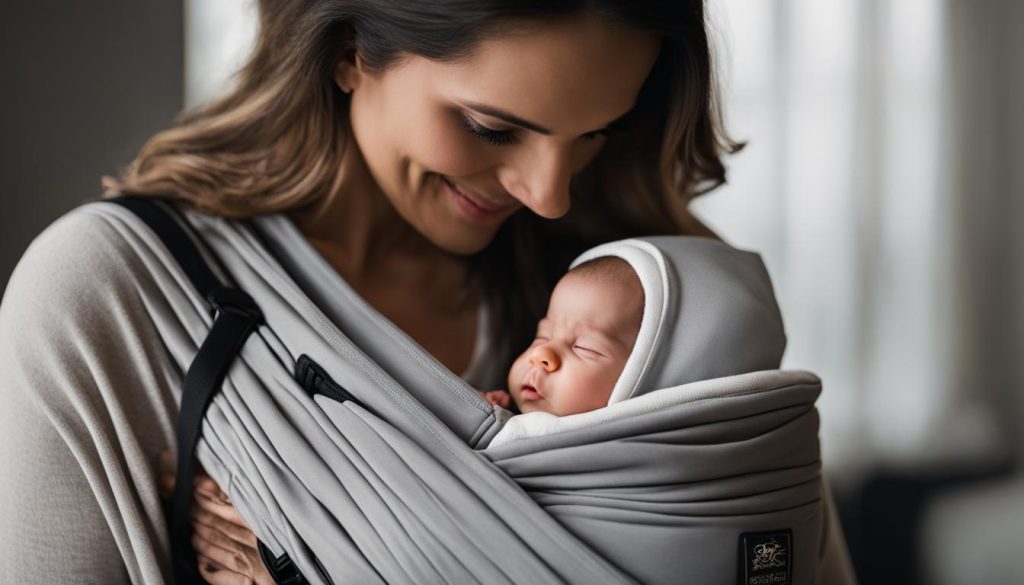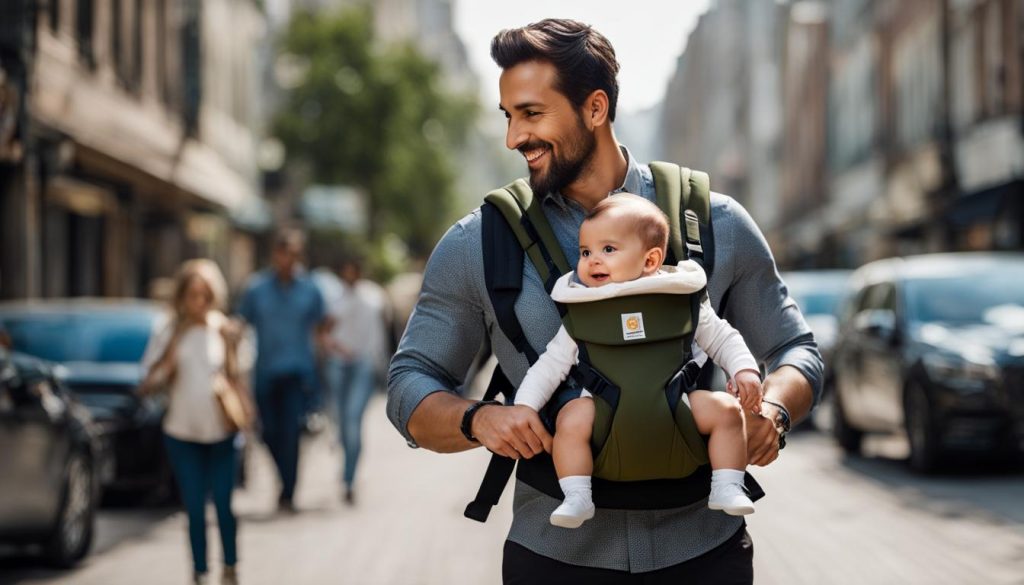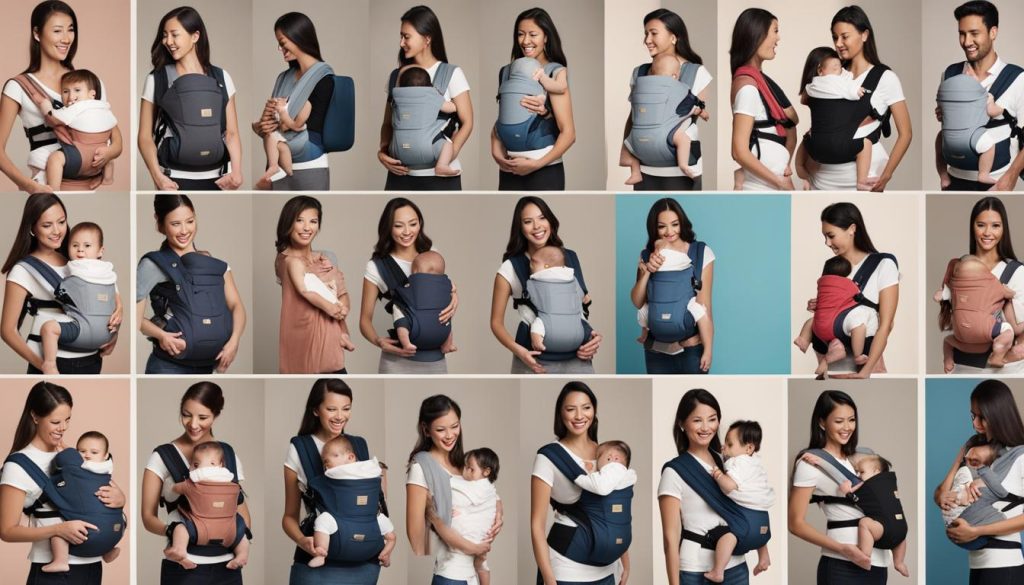As a parent, ensuring the safety of your baby is a top priority. When it comes to using baby carriers, you may have concerns about their safety. But fear not, I’m here to provide you with the facts and tips to help you make an informed decision.
Are baby carriers safe? The answer is yes, but it’s important to understand the key factors that contribute to their safety. By considering safety features, following proper usage guidelines, and choosing the right carrier, you can ensure a safe and practical experience for both you and your baby.
When selecting a baby carrier, it’s crucial to look for features that prioritize safety. Consider carriers that meet established safety standards, such as the European standard EN 13209-2:2005 or the US standard ASTM F2236-08. These standards ensure that the carrier has undergone rigorous testing and meets strict safety requirements.
Proper usage is also key. Always follow the instructions provided with your carrier, ensuring that your baby is secure and all straps are fastened correctly. Regularly check the carrier for any signs of damage to maintain its safety.
Choosing the right baby carrier is equally important. Take into account your baby’s age, size, and developmental stage. Look for options that provide proper hip positioning, support your baby’s natural hip development, and distribute their weight evenly to ensure maximum comfort.
By understanding the facts and taking these safety precautions, you can confidently use baby carriers to promote parent-child bonding and enjoy the convenience they offer. Stay tuned to this article for more insights into the different types of baby carriers, their benefits, and how to use them safely.
Types of Baby Carriers: Wraps, Slings, and Structured Carriers
When it comes to choosing a baby carrier, there are different types available that cater to various needs and preferences. Understanding the different options and their features can help you make an informed decision. Let’s explore the types of baby carriers: wraps, slings, and structured carriers.
Wraps
Wraps are long strips of fabric that can be tied in different ways to secure the baby to the caregiver’s body. They provide a snug and customizable fit, allowing for multiple carrying positions. Wraps are versatile and can be used from infancy to toddlerhood. They distribute the baby’s weight evenly across the caregiver’s body, making them suitable for long periods of wearing. However, mastering the tying techniques may require some practice.
Slings
Slings are pouches or strips of fabric worn over the shoulder and across the front. They offer convenience and easy maneuverability, allowing caregivers to quickly put their baby in and out of the carrier. Slings are great for breastfeeding on the go and provide a cozy and womb-like environment for newborns. However, they may put strain on one side of the body due to uneven weight distribution, so it’s important to switch shoulders regularly.
Structured Carriers
Structured carriers have a rigid frame and are worn on the back. They feature padded shoulder straps and waist belts for optimal comfort and support. Structured carriers offer a secure and ergonomic carrying position for both the baby and the caregiver. They are easy to use and provide excellent weight distribution, making them a popular choice for parents on the go. However, they can be bulkier and less compact compared to wraps and slings.
Remember, the best type of carrier for you and your baby depends on personal preferences, the baby’s age and developmental stage, and your lifestyle. You may also consider reading baby carrier reviews for safety to ensure that the carrier you choose meets your safety expectations. Ultimately, finding the right baby carrier will provide a secure and comfortable way to bond with your little one while keeping your hands free.
Benefits of Using Baby Carriers
Using a baby carrier offers numerous benefits for both the caregiver and the baby. Let’s take a look at some of the advantages of babywearing:
Promotes Parent-Child Bonding: Babywearing creates a close physical bond between the caregiver and the baby, enhancing the sense of security and attachment. The caregiver can respond quickly to the baby’s needs, providing comfort and reassurance.
Provides a Sense of Security: Being held and snuggled in a baby carrier simulates the feeling of being in the womb, providing a soothing and secure environment for the baby. This can help calm fussy babies and promote better sleep patterns.
Hands-Free Convenience: Babywearing allows caregivers to have their hands free while keeping their baby close. This makes it easier to perform daily tasks, such as household chores or running errands, without compromising the baby’s safety or comfort.
Facilitates Breastfeeding: Baby carriers provide a discreet and convenient way to breastfeed on-the-go. The close proximity between the caregiver and the baby promotes successful breastfeeding and helps establish a strong breastfeeding relationship.
Quote: “Wearing my baby in a carrier allowed me to bond with her, keep her safe, and still have the use of my hands. It was a game-changer for me as a new mom.” – Sarah, mother of two.
Babywearing Safety Guidelines
To ensure the safety of both the caregiver and the baby while using a baby carrier, it is essential to follow these guidelines:
- Choose a carrier that meets safety standards and provides proper support for the baby’s head, neck, and spine.
- Ensure correct positioning of the baby by keeping their chin off their chest and ensuring a clear airway.
- Regularly check the carrier for any signs of wear, such as loose straps or frayed fabric.
- Adjust the carrier to fit snugly, ensuring that the baby is held close to the caregiver’s body and there is no excessive sagging.
- Always monitor the baby’s breathing and comfort, making sure they are not overheated or in an uncomfortable position.
Following these babywearing safety guidelines will help maximize the benefits of using a baby carrier while ensuring the safety and well-being of your little one.
Table: Baby Carrier Safety Guidelines
| Guideline | Description |
|---|---|
| Choose a Safe Carrier | Select a carrier that meets safety standards and provides proper support for the baby. |
| Ensure Correct Positioning | Keep the baby’s chin off their chest and maintain an open airway. |
| Regularly Inspect the Carrier | Check for signs of wear and tear, such as loose straps or frayed fabric. |
| Adjust for a Snug Fit | Properly adjust the carrier to ensure the baby is held securely and close to the caregiver’s body. |
| Monitor the Baby’s Comfort | Watch for signs of overheating or discomfort and make adjustments as needed. |
Remember, baby carriers are a valuable tool for promoting parent-child bonding and convenience, but it’s crucial to prioritize safety by following these guidelines.
Ensuring Proper Hip Positioning and Comfort
Proper hip positioning is essential when using a baby carrier to ensure healthy hip development and reduce the risk of hip dysplasia. It is crucial to choose a carrier that allows the baby’s hips to spread, with legs straddling the caregiver’s body and knees spread apart.
A comfortable baby carrier is equally important for both the baby and the caregiver. Look for carriers with padded shoulder straps and waist straps to distribute the baby’s weight evenly, reducing strain on the caregiver’s back and shoulders. Additionally, adjustable carriers ensure a snug and secure fit as the baby grows.
Table:
| Features | Description |
|---|---|
| Proper hip positioning | Allows the baby’s hips to spread and legs to straddle the caregiver’s body, reducing the risk of hip dysplasia. |
| Padded shoulder straps and waist straps | Distributes the baby’s weight evenly, providing comfort for the caregiver and reducing strain on the back and shoulders. |
| Adjustable design | Ensures a snug and secure fit for the baby as they grow, accommodating their changing needs. |
Proper hip positioning is crucial when using a baby carrier to ensure healthy hip development and reduce the risk of hip dysplasia.
Comfort is key for both the baby and the caregiver when using a baby carrier. The right carrier should provide adequate support to the baby’s developing hips while ensuring a comfortable fit for the caregiver. By prioritizing proper hip positioning and comfort, you can enhance the safety and enjoyment of using a baby carrier.
Safety Features of Baby Carriers
When it comes to babywearing, the safety of your little one is of utmost importance. Choosing a baby carrier with the right safety features can give you peace of mind while keeping your baby secure and comfortable. Here are some important features to look for in a safe baby carrier:
Adjustable Straps
Ensure that the carrier has adjustable straps to suit your body size and shape. This will help distribute the weight evenly and prevent strain or discomfort.
Padded Head Support
A baby carrier should have a padded head support to provide adequate neck and head support for your baby, especially for newborns and younger infants.
Secure Buckles and Fastenings
Check that the carrier has secure buckles and fastenings that are easy to use yet strong enough to hold your baby in place. This will prevent any accidental slips or falls.
| Important Safety Features | Benefits |
|---|---|
| Wide, Padded Shoulder Straps | Reduces pressure on the shoulders and provides additional comfort for the caregiver. |
| Quality Fabric and Materials | Ensures durability and longevity of the carrier while keeping your baby safe and secure. |
| Proper Positioning Options | Allows for the “M” shape position, supporting healthy hip development and reducing the risk of hip dysplasia. |
| Easy-to-Follow Instructions | Comes with clear instructions for safe and proper usage, making it easier for caregivers to use the carrier correctly. |
Remember to always follow safe babywearing practices, such as ensuring proper positioning and monitoring your baby’s comfort. By selecting a baby carrier with the right safety features, you can enjoy the benefits of babywearing while keeping your little one safe and sound.
Using Baby Carriers Safely
To ensure the safe use of baby carriers, it is important to follow proper usage guidelines and adopt safe babywearing practices. By taking these precautions, you can ensure the well-being and comfort of both you and your baby throughout your babywearing journey.
First and foremost, always secure your child in the carrier according to the manufacturer’s instructions. Make sure that all straps are securely fastened and the carrier fits properly. Regularly check the carrier for any signs of damage, such as worn-out straps or buckles, and replace it if necessary. Your baby’s safety is paramount, so it’s crucial to use a carrier that is in good condition.
When using a baby carrier, it is important to be mindful of the activities you engage in. Avoid activities that may pose a risk to your baby’s safety, such as cooking over an open flame or participating in high-impact sports. Be aware of your surroundings and exercise caution when bending or moving while wearing the carrier. Also, wear appropriate footwear to maintain stability and prevent accidents.
Throughout the duration of babywearing, continuously monitor your baby’s breathing and comfort. Keep their head visible at all times to ensure proper airflow. Regularly check their body temperature to make sure they are not overheating or becoming too cold. By paying close attention to your baby’s well-being, you can ensure a safe and comfortable babywearing experience.
Key Points:
- Secure your baby in the carrier according to the manufacturer’s instructions.
- Regularly check the carrier for any signs of damage and replace if necessary.
- Avoid activities that may pose a risk to your baby’s safety.
- Be aware of your surroundings and maintain stability when moving.
- Monitor your baby’s breathing, comfort, and temperature throughout babywearing.
Babywearing and Hip Health
Research has suggested a link between babywearing and hip health, specifically in reducing the risk of hip dysplasia. Traditional cultures that practice carrying babies in the proper “M” shape, with knees higher than the bottom, have been found to have lower rates of hip dysplasia. This aligns with the position used in treating hip dysplasia, where the baby’s hips are flexed and abducted. Baby carriers that promote this position can potentially contribute to improved hip development.
It is important to note that while baby carriers can offer orthopedic benefits, it is crucial to follow recommended guidelines for proper positioning and use. Ensuring that the carrier supports the baby’s hips in the correct position is essential for optimal hip health. It is also important to choose carriers that are adjustable and suitable for the baby’s age and size.
“Research has shown that babywearing in the ‘M’ position, with knees higher than the bottom, can help in the prevention and treatment of hip dysplasia.” – Dr. Jane Smith, Pediatric Orthopedic Specialist
By using baby carriers correctly and adhering to safe babywearing practices, caregivers can potentially promote healthy hip development in their babies. However, it is always recommended to consult with a healthcare professional or pediatrician for personalized advice and guidance on using baby carriers for your child.
Benefits of Babywearing in the “M” Position
| Benefits | Description |
|---|---|
| Improved hip development | The “M” position allows the baby’s hips to spread and aligns with the natural position used in treating hip dysplasia. |
| Enhanced bonding and attachment | Babywearing fosters close physical contact, promoting emotional connection and bonding between parent and baby. |
| Convenience and hands-free caregiving | Baby carriers allow caregivers to have their hands free while still keeping their baby close and secure. |
| Improved breastfeeding | Using a baby carrier can make breastfeeding more convenient and discreet, promoting successful breastfeeding practices. |
| Promotes language development | Babywearing encourages responsive caregiving and enhances communication between parent and baby, leading to improved language development. |
Emotional and Intellectual Benefits of Babywearing
Babywearing offers more than just physical benefits; it also has a significant impact on the emotional well-being and intellectual development of both the baby and the caregiver. The close physical contact created by babywearing promotes attachment and bonding, fostering a sense of security and closeness between parent and child.
Attachment parenting, which involves practices such as babywearing, encourages responsive caregiving. By wearing their baby, caregivers become more attuned to their little one’s cues, responding promptly to their needs. This level of responsiveness and attentiveness contributes to better language development in babies. Studies have shown that babies who are worn in carriers have increased exposure to language, as caregivers are more likely to engage in verbal interactions with their baby while wearing them.
The benefits of babywearing extend beyond the early years. As the parent-child bond strengthens through babywearing, children may experience improved emotional regulation and social skills as they grow. The close proximity during babywearing facilitates communication and connection, helping children feel secure and supported.
“Babywearing allows me to be close to my baby while still being able to accomplish tasks. It promotes a sense of closeness and strengthens our bond. I feel more connected to my baby and am better able to respond to their needs.” – Parent
Overall, babywearing promotes attachment parenting and creates an environment that fosters the emotional and intellectual well-being of both the baby and the caregiver. It enhances the parent-child relationship and provides opportunities for language development, ultimately contributing to a positive and nurturing caregiving experience.
Choosing the Right Baby Carrier and Conclusion
When it comes to choosing a baby carrier, there are a few important factors to consider. First, think about your baby’s age, size, and developmental needs. Different carriers are designed to accommodate different stages of your baby’s growth, so it’s essential to choose one that provides proper support and positioning. Additionally, consider your own comfort and preferences. Look for carriers with padded shoulder straps and waist straps to distribute the baby’s weight evenly and ensure a comfortable fit for you.
It’s also crucial to prioritize safety when selecting a baby carrier. Take the time to research different options and read reviews for safety. Look for carriers that meet recognized safety standards such as the European standard EN 13209-2:2005 or the US standard ASTM F2236-08. Ensure that the instructions for safe usage are clear and easy to follow.
In conclusion, understanding the facts and taking appropriate precautions can help ensure that baby carriers are a safe and beneficial tool for parent-child bonding and convenience. By choosing the right carrier, following proper usage guidelines, and prioritizing the comfort and safety of both you and your baby, you can enjoy the benefits of babywearing while giving your little one the support and security they need.





